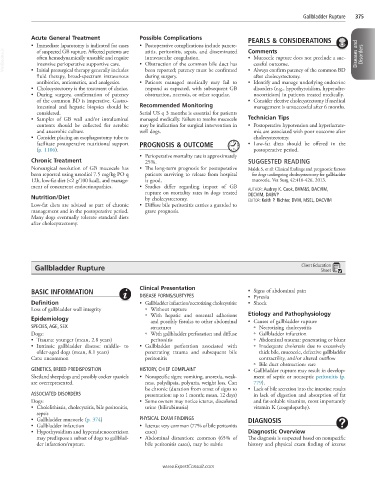Page 789 - Cote clinical veterinary advisor dogs and cats 4th
P. 789
Gallbladder Rupture 375
Acute General Treatment Possible Complications PEARLS & CONSIDERATIONS
• Immediate laparotomy is indicated for cases • Postoperative complications include pancre- Comments
VetBooks.ir often hemodynamically unstable and require • Obstruction of the common bile duct has • Mucocele rupture does not preclude a suc- Diseases and Disorders
atitis, peritonitis, sepsis, and disseminated
of suspected GB rupture. Affected patients are
intravascular coagulation.
cessful outcome.
intensive perioperative supportive care.
• Initial presurgical therapy generally includes
during surgery.
fluid therapy, broad-spectrum intravenous been reported; patency must be confirmed • Always confirm patency of the common BD
after cholecystectomy.
antibiotics, antiemetics, and analgesics. • Patients managed medically may fail to • Identify and manage underlying endocrine
• Cholecystectomy is the treatment of choice. respond as expected, with subsequent GB disorders (e.g., hypothyroidism, hyperadre-
• During surgery, confirmation of patency obstruction, necrosis, or other sequelae. nocorticism) in patients treated medically.
of the common BD is imperative. Gastro- • Consider elective cholecystectomy if medical
intestinal and hepatic biopsies should be Recommended Monitoring management is unsuccessful after 6 months.
considered. Serial US q 3 months is essential for patients
• Samples of GB wall and/or intraluminal managed medically. Failure to resolve mucocele Technician Tips
contents should be collected for aerobic may be indication for surgical intervention in • Postoperative hypotension and hyperlactate-
and anaerobic culture. well dogs. mia are associated with poor outcome after
• Consider placing an esophagostomy tube to cholecystectomy.
facilitate postoperative nutritional support PROGNOSIS & OUTCOME • Low-fat diets should be offered in the
(p. 1106). postoperative period.
• Perioperative mortality rate is approximately
Chronic Treatment 25%. SUGGESTED READING
Nonsurgical resolution of GB mucocele has • The long-term prognosis for postoperative Malek S, et al: Clinical findings and prognostic factors
been reported using ursodiol 7.5 mg/kg PO q patients surviving to release from hospital for dogs undergoing cholecystectomy for gallbladder
12h, low-fat diet (<2 g/100 kcal), and manage- is good. mucocele. Vet Surg 42:418-426, 2013.
ment of concurrent endocrinopathies. • Studies differ regarding impact of GB AUTHOR: Audrey K. Cook, BVM&S, DACVIM,
rupture on mortality rates in dogs treated
Nutrition/Diet by cholecystectomy. DECVIM, DABVP
EDITOR: Keith P. Richter, DVM, MSEL, DACVIM
Low-fat diets are advised as part of chronic • Diffuse bile peritonitis carries a guarded to
management and in the postoperative period. grave prognosis.
Many dogs eventually tolerate standard diets
after cholecystectomy.
Gallbladder Rupture Client Education
Sheet
Clinical Presentation
BASIC INFORMATION • Signs of abdominal pain
DISEASE FORMS/SUBTYPES • Pyrexia
Definition • Gallbladder infarction/necrotizing cholecystitis: • Shock
Loss of gallbladder wall integrity ○ Without rupture
○ With hepatic and omental adhesions Etiology and Pathophysiology
Epidemiology and possibly fistulas to other abdominal • Causes of gallbladder rupture
SPECIES, AGE, SEX structures ○ Necrotizing cholecystitis
Dogs: ○ With gallbladder perforation and diffuse ○ Gallbladder infarction
• Trauma: younger (mean, 2.8 years) peritonitis ○ Abdominal trauma: penetrating or blunt
• Intrinsic gallbladder disease: middle- to • Gallbladder perforation associated with ○ Inadequate choleresis due to excessively
older-aged dogs (mean, 8.1 years) penetrating trauma and subsequent bile thick bile, mucocele, defective gallbladder
Cats: uncommon peritonitis contractility, and/or altered outflow
○ Bile duct obstruction: rare
GENETICS, BREED PREDISPOSITION HISTORY, CHIEF COMPLAINT • Gallbladder rupture may result in develop-
Shetland sheepdogs and possibly cocker spaniels • Nonspecific signs: vomiting, anorexia, weak- ment of septic or nonseptic peritonitis (p.
are overrepresented. ness, polydipsia, polyuria, weight loss. Can 779).
be chronic (duration from onset of signs to • Lack of bile secretion into the intestine results
ASSOCIATED DISORDERS presentation: up to 1 month; mean, 12 days) in lack of digestion and absorption of fat
Dogs: • Some owners may notice icterus, discolored and fat-soluble vitamins, most importantly
• Cholelithiasis, cholecystitis, bile peritonitis, urine (bilirubinuria) vitamin K (coagulopathy).
sepsis
• Gallbladder mucocele (p. 374) PHYSICAL EXAM FINDINGS DIAGNOSIS
• Gallbladder infarction • Icterus: very common (77% of bile peritonitis
• Hypothyroidism and hyperadrenocorticism cases) Diagnostic Overview
may predispose a subset of dogs to gallblad- • Abdominal distention: common (65% of The diagnosis is suspected based on nonspecific
der infarction/rupture. bile peritonitis cases), may be subtle history and physical exam finding of icterus
www.ExpertConsult.com

